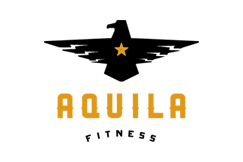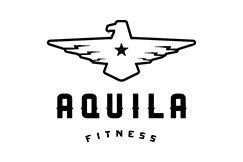Power Clean 3-3-3-3-3
3 Rounds For Time:
12 Heavy Front Squats*
21 Push Ups
400m Run
*Try to go as heavy as you can clean to the shoulders and perform an unbroken set of 12 for you first round.
When teaching beginners to Olympic lift, we see the most success from the hang position as it is the simplest starting position. Lifting from the floor adds another layer of complexity and therefore more chances to get out of position and screw up the lift. One of the major problems that occurs when starting from the floor has to due with the fact that the weight is out in front of our bodies. Weight in front of the body tends to pull lifters forward onto their toes. If a lifter cannot get his or her weight back onto their heels they will be out of position and all kinds of bad things tend to happen including early arm pulls, incomplete opening of the hips, general lack of power and missed lifts forward. We could just always have you guys lift from the hang, but because we know many of you enjoy participating in the Open every year and want to do as well as you can, it is necessary for us to teach you to lift form the floor here and there. In today’s post I hope to give you a visual of what can go wrong and what needs to happen for things to go well.
Yesterday I spent some time scouring the web trying to find some images to help you all visualize the power clean. Good images that help explain Olympic lifting are difficult to find. The image I found is pretty good, but the more I looked at it, I began to see that it seems to show an example of the exact problem I wanted to discuss today. The lifter starts his lift forward (as seen in the second image) and never gets back over his heels which causes him to catch or receive the weight out in front of his feet.
To illustrate this point, I added the vertical green lines to represent where the weight is centered and the red X to show where I believe the weight should be centered. The blue arrows show the direction I would like to shift this lifters body to put him in a stronger position.

Click to enlarge image
Image borrowed and tweaked from http://champion-athletes.net/site/articles/why-olympic-lifts/
A couple things to note before I go further. This image was of a full clean into a squat and I cut off the final image to discuss only the power clean. If the lifter stopped descending at the last image shown above and stood up, it would be a power clean. The mechanics of a power clean or squat clean should be the same with the exception of ending in a squat vs. staying above parallel in the receiving position. Also, there are many different opinions and styles of executing and coaching these lifts, so someone else out there may have an argument different than mine. Please comment if you have a different opinion.
Briefly on the concept of 1st, 2nd and 3rd pull for those of you who may be unfamiliar with those terms. The 1st pull is the part of the lift where you bring the bar from the floor to above the knees and is similar to the start of a deadlift. The 2nd pull is the part of the lift where the bar passes the knees and the lifter transitions from a deadlift-like position into a jumping position creating speed and elevation on the barbell. And the 3rd pull starts at the top of the jump when the lifter shrugs and pulls themselves back down under the bar to receive it. These movements all blend together into the symphony of movement that make up the clean or the snatch.
It is important to note that in the starting position many lifters start with the load centered over the ball of the foot and transition the weight back as they begin the 2nd pull. The lifter in the sequence above never gets the weight back over the heel and ends up receiving the bar out in front of the feet as can be seen by the green lines and the X’s.
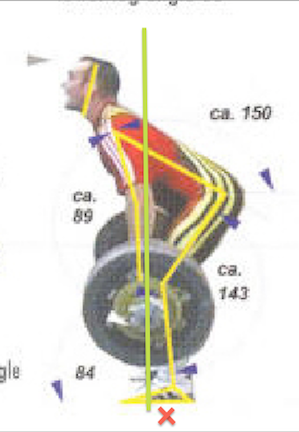
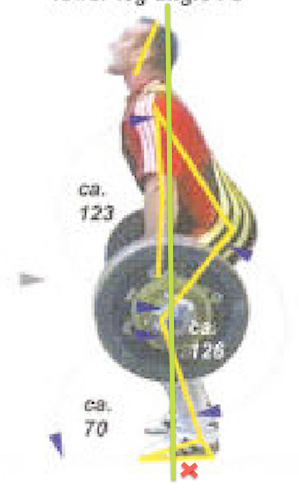
These pictures show the lifters original position at the end of the 1st pull and beginning of the 2nd pull, both of which I believe are a little forward over the toes.
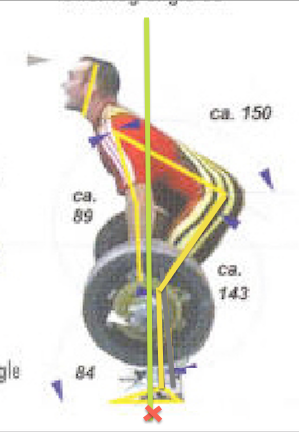

In these pictures I changed the shin angle making it more vertical. Essentially this change shifts the lifter’s body back over his heels more. Take a close look at the difference in position as I believe this is a crucial point to making successful lifts. The difference in these two sequences may appear slight, but can make all the difference.
Since it is likely the barbell will be starting over the front of the foot, it is necessary that the knees sweep back out of the way allowing the barbell to come up straight. During the transition from the 1st pull to the 2nd pull, the lifter must fight to get his weight back on the heels and off of the toes. The shin angle should be close to vertical as the bar passes the knees which allows the the lifter to keep his weight back and the bar path coming back over the heel. This position also puts a great load into the hamstrings which will be transferred into explosive power during the 2nd pull or jumping phase of the lift.
The main point today is to make sure your knees sweep back and you get your weight back on your feet as you transition into the 2nd pull. If the knees stay forward, the bar must travel around the knees putting the bar too far forward and you on your toes. Another important point here is that you should be aggressively driving your knees out to the sides which both allows for the bar to stay closer underneath the body and creates more tension in the hips.
For me personally, I tried starting over the forefoot and shifting back for a couple years. I never really got the hang of that shift and found myself on my toes way too many times. Eventually went back to starting with my weight centered over the heels and just staying there throughout the lift. For beginner lifters out there, I recommend trying to stay on your heels from the get go. Some coaches may disagree with this advice, and it may not work for everyone based on different limb lengths, but I find that it helps simplify a tremendously complicated movement.
Halting clean deadlifts are a good movement that I find helpful in practicing the right positions when lifting from the floor. You can use a moderate weight, set up for the clean, then lift the bar pausing for a couple seconds in various positions to check that you are in fact on your heels and carrying significant load in the hamstrings. Another important coaching point is to practice lifting the bar from the floor correctly when practicing lifts from the hang. Too often lifters pick up barbells from the out of position because they are planning to lift from the hang. Take every opportunity to practice correct positions.
Check out this video from CrossFit.com with Coach Burgener discussing the idea of staying back on the heels and a simple drill that helps develop the feeling.
http://www.youtube.com/watch?v=EJkkRy9PEhg
The main point here is to get your knees back out of the way and get your weight heavy on the heels for your 2nd pull. If you can do that, you are much more likely to lift big weights or to lift the lighter weights more efficiently. As I mentioned earlier, I invite any questions or other opinions on technique to today’s comment section.

